Ultimate Guide To Snorkelling With Kids & 20 Best Places
Thinking of snorkelling with your kids?
We’ve been travelling with our kids since they were both babies and because Carl is a sailor a large part of our travels have taken us to some incredible beaches. Carl loves free diving and we are both huge fans of snorkelling. It was only natural for us that as soon as our boys were ready we’d start to teach them to snorkel. Cameron is three years old and has been learning to snorkel since he was two years old. We love snorkelling with kids because is such a rewarding experience for the entire family.
We’ve taken a very slow and structured approach to teaching Cameron so that he goes at his own pace. We also take Dylan our baby out on our adventures, yes, you heard that right! Dylan joins us on our paddle board which we take out snorkelling with us. We’re hoping that when he’s ready he’ll also want to snorkel.
We want to share with you some cool things that we’ve learnt along the way so that we can help more families snorkel together. And at the end, we’ve listed some of the destinations to try snorkelling as a whole family.
The best way to teach your kids to snorkel
We’ve spent the past year teaching Cameron to snorkel and the top thing that we’ve learnt is that it needs to be an enjoyable experience.
To help you teach your little snorkeler we’ve listed out the steps that we found to work for us.
Step 1 – Make it fun by getting excited about snorkelling with your kids
You’ve got to make it fun. Before we even thought about to teaching Cam, we started by hyping up all of the fun things that we’d see if we went snorkelling, like sea turtles and rays.
A good idea that worked well for us was to take him to loads of aquariums to see the tropical fish he might see in real life and we watched cool kids TV shows such as Octonauts where they explore underwater marine ecosystems. Getting kids excited helps to give them a reason to give it a go.
Talk to your kids about what sea creatures they might see underwater, they’ll get excited and they’ll want to give it a go!
Step 2 – Get your kids the right equipment for snorkelling
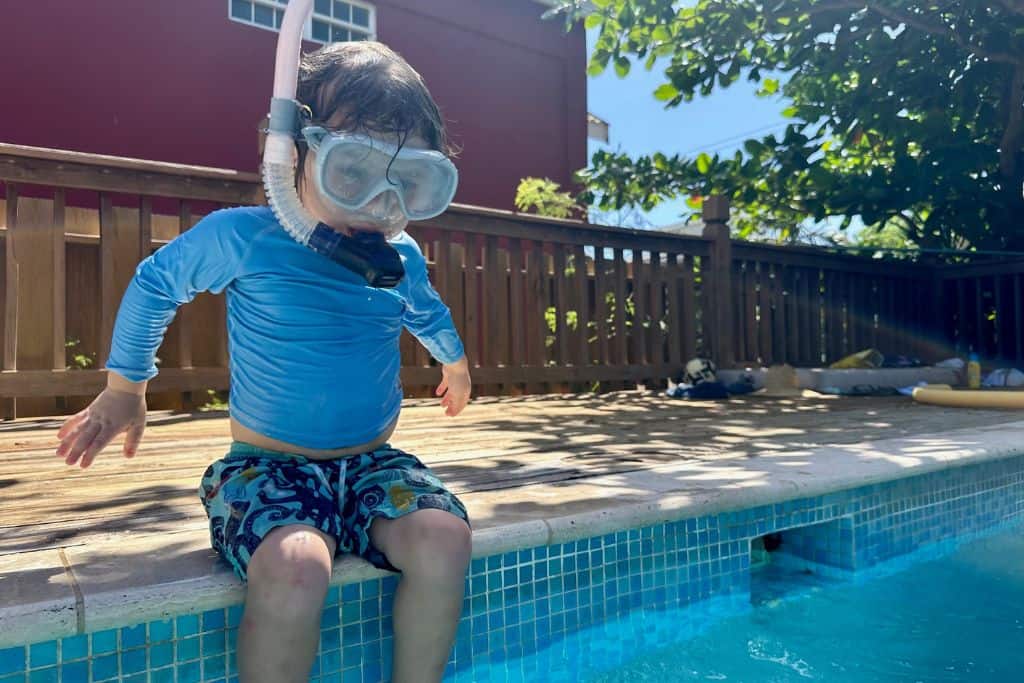
One of the best things about snorkelling is that it doesn’t require a lot of fancy and expensive snorkelling equipment, so kitting your kids out with a full set of the best snorkel gear won’t need to break the bank. Just remember you’ll need to sure the proper gear fits properly, or your young snorkelers will be super distracted in the water! We’ve put together short guide on picking the right snorkelling gear.
Snorkel masks for snorkelling with kids
A regular kids snorkel mask will cover the eye and nose area and leave the mouth free for a snorkel tube. The snorkel tube then delivers air from the surface to the child while their face is submerged. It attaches to the mask strap to keep it in place.
An alternative is full-face masks, which cover the entire face area (eyes, nose, and mouth) and have an integrated snorkel that extends to the surface. Whilst full-face snorkel masks are great for beginners they aren’t always suitable later on when children want to dive deeper underwater.
We chose to use a regular snorkelling mask we bought from Decathlon with Cameron with a soft strap. The soft strap helped immensely as his original mask had a rubber strap which he complained kept pulling at his hair. Also, they’re one of the only companies that do a smaller enough size for very young kids.
Snorkel tubes for snorkelling with kids
Classic snorkel tubes are simple and extend from the mouth to the surface. And any water that enters the snorkel can be expelled with a sharp exhalation that forces the water back out the top. Although these are the simplest (and most reliable) snorkel tubes we found that Cam was having difficulties clearing his snorkel. So we changed over to a snorkel with a guard at the top (to prevent water from entering) and a purge valve at the bottom of the snorkel. It was way easier for him to blow the unwanted water out of a valve than out the top of a snorkel!
Snorkel fins for snorkelling with kids
Like masks, it’s super important that your kid’s snorkel fins fit them well. Because if they’re too tight, they’ll end up with numb toes. And if they’re too large they could end up with blisters (or accidentally losing a fin!). You’ll find both closed- and open-heeled fins available, and they each have their own pros and cons. We bought open-heeled adjustable ones for Cam as they were the smallest we could find for little kids and it also means we can adjust them as his feet get bigger. He finds them easy enough to get on himself.
Snorkel vests or something to keep them bouyant
Snorkel vests are designed to help you float on the water’s surface. They also give extra buoyancy so your kids can get used to their gear without working too hard to stay afloat.
Unlike a life jacket or life vest, snorkel vests are streamlined and let you swim with your face in the water. Also, you can adjust the amount of air inside them so that you can deflate air as your child’s confidence improves but keep the vest on ‘just in case’.
We don’t have a snorkel vest as Cam has never been a big fan of any sort of vest. Instead, we use foam armbands (as they won’t accidentally deflate like blow-up ones), and he’s still able to easily get his face into the water.
Sun protection
Most of the best places to go snorkelling with kids usually involve being in tropical and sunny locations. In these parts of the world the sun is strong and can be a serious danger to young skin. Both of our boys always wear a UV protection rash vest with SPF 50+ protection. And, for any bits of skin on show, we make sure you apply a generous amount of waterproof reef-safe sunscreen.
Step 3 – Start by snorkelling in the swimming pool with your kids

We know that kids Crawl, walk then run. In the case of snorkelling with kids, it’s pool, beach, boat!
A great way to start is by using a swimming pool with your kids and practising with their snorkel gear in a safe environment. If you’re on holiday then a hotel pool is the perfect place to start. Kids need to get comfortable using a mask for the first time. And once they are happy in the mask, you can add on the snorkel tube and they can practice breathing through a snorkel without the distractions of the ocean.
Young children love to play games, so we spent a lot of time dropping things in the swimming pool for Cam to look at. He was so excited that he could see underwater! We found that the easiest way to teach the snorkel tube breathing was to simulate using it out of water. And then gently starting to use it in the water. And once in the water we kept demoing how to blow hard to get any water out of the tube. It took a lot of fun practice and drinking pool water to get it right!
Step 4 – Visit a sandy beach with shallow calm waters for your first snorkelling adventure
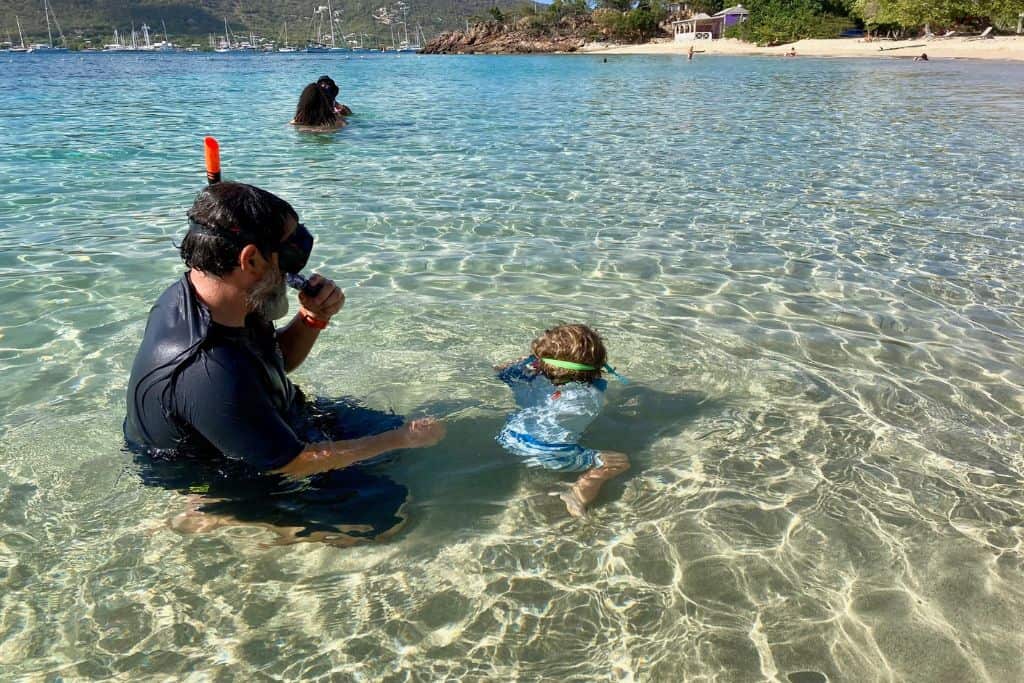
For their first snorkelling trip, you’ll want to find a great place that has a sandy beach. Along with shallow calm waters so that you can walk easily walk into the sea. This means that if your child gets a leaky mask or a mouthful of water from a wave, they can stand up and reset.
We spent days at Pigeon Beach in Antigua practising walking into and out of the sea. Then putting his snorkel mask on and putting his face into and out of the water. We then eventually taught him to walk into the water with his snorkel fins on.
A sandy beach is ideal as it means they can touch down their feet without worrying about balancing on rocks, or dodging things like sear urchins. Yes, we’ve had that happen before, and kids with urchin in their feet aren’t much fun!
Step 5 – Head out into deeper water by using something for them to float on
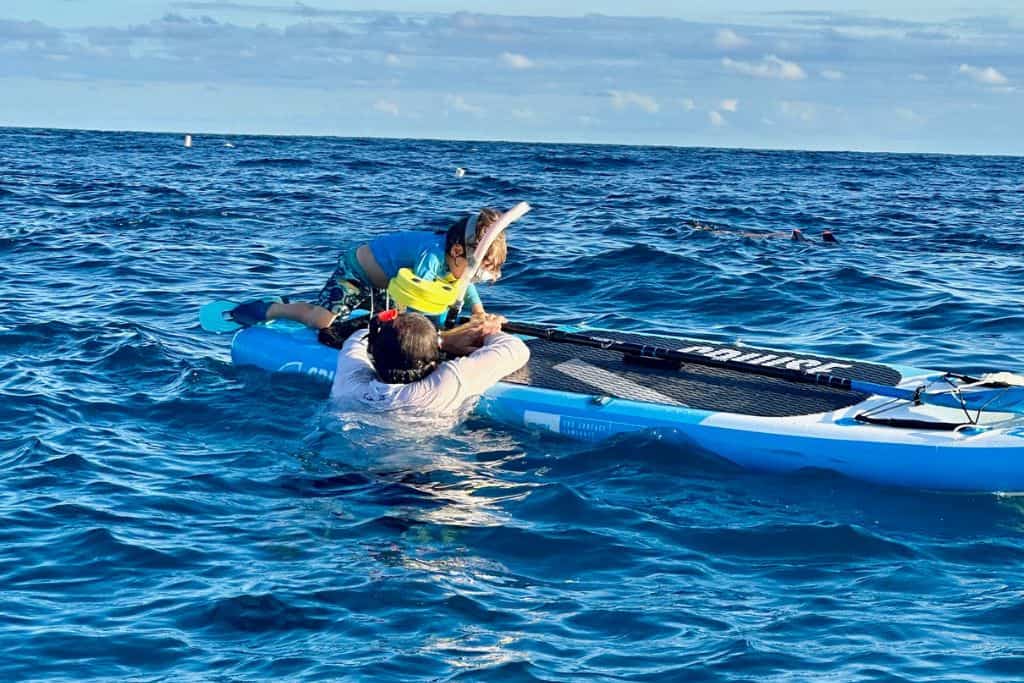
As is the case with other small children, Cam can get tired quickly from swimming. To help him get into the open water and out to reefs, we sit him on a paddle board and paddle him into the deeper water. It also helps that if he needs a break, has problems with his mask, or needs a drink. As he can simply jump onto the board.
We’ve also been taking 9-month-old Dylan out on the paddle board so that we can go out as an entire family. Carl and I swap over who gets to snorkel with Cam whilst the other plays in the water or on the board with Dylan.
Step 6 – Practice snorkelling skills to build more confidence
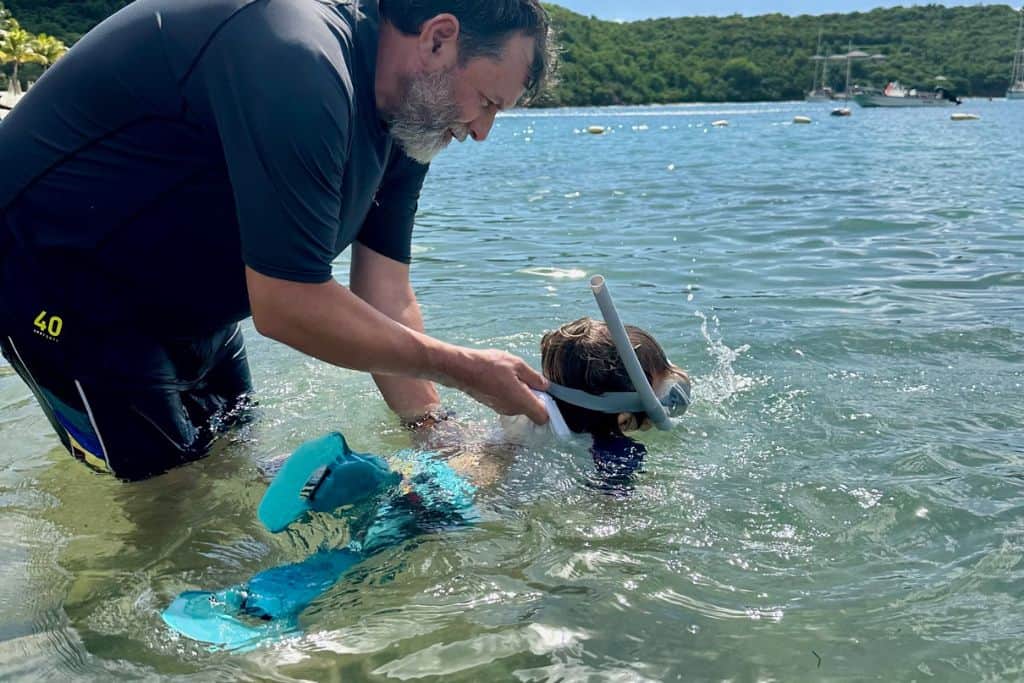
Even though Cam is happy to head out snorkelling there are still lots of important snorkelling skills that we are teaching him as we go. These are great things like, how to:
- empty the snorkel when water gets in, either by dumping it out or with a big exhale
- defog his mask by spitting and cleaning it beforehand (or you can use anti-fog spray if you prefer)
- hand signal underwater. We’re still in the early stages and keep it simple. He’s learning things such as ok, stop and slow down at the moment. Plus the occasional hand signal when we see the sea turtles
- clearing his mask by lifting just the bottom, and not throwing the mask off of his face
- to remain calm when he sees something cool, like sea turtles, because his excitement can scare them off
Other top tips for snorkelling with kids
Safety first
Make sure you all have the right gear on, including masks, snorkel tubes, and fins that fit snugly. Life jackets or snorkel very are essential, especially for younger kids or older kids that are less confident swimmers. At the beginning of each snorkel session it’s important to emphasise your safety rules. Things such as staying close to the shore, always snorkelling with a buddy, and not disturbing marine life.
Plan short sessions
We always keep our snorkelling sessions short and engaging. Because for younger kids like Cam this helps to prevent fatigue. Also, frequent breaks on the boat or the beach can help keep them enthusiastic as kids love to chat about what they have seen. Also, make sure to have snacks and water readily available for breaks between snorkelling sessions.
Take your own snorkelling gear
Most hotels and boat tours will provide you with snorkel gear, however, this will usually be in an adult size. We’ve never been on a tour or to a hotel that has small enough snorkel gear for kids. We’d recommend always taking one for your kids.
Check weather conditions and be aware of the tide
You should check for good weather conditions and tidal strength before heading out. You should avoid snorkelling in windy or stormy weather as it can make the experience uncomfortable and less safe. Also avoid strong currents especially rip tides.
If it’s sunny then ensure that any exposed skin is protected from the sun with reef-safe sun cream or a UV-rated protective rash vest.
Encourage underwater exploration
Make it fun by encouraging your younger children to identify colourful fish and other marine creatures. You could bring a waterproof field guide to help their learning experience. At the end of the day we always ask questions about what we’ve seen and share his excitement.
Capture memories
Young kids love seeing their underwater adventures so taking an underwater camera or a waterproof phone case will mean you can capture their magical moments.
Respect marine life
This is super important, as we should all teach our kids to admire marine life from a respectful distance. And also show them the importance of preserving ocean ecosystems. We always emphasis the importance of not touching or disturbing the underwater sea creatures. It’s about having an enjoyable snorkelling experience.

20 Best destinations in the world for snorkelling with kids
No article on snorkelling with kids would be complete without a guide to some of the best places in the world to go. We’ve researched (and started our own bucket list) of the best places to share with you.
1. Great Barrier Reef, Australia
The Great Barrier Reef is off the coast of Australia. It is ranked as one of the original seven natural wonders of the world. It is an exceptional destination for families seeking an unforgettable snorkelling experience with kids with vibrant marine life.
The Great Barrier Reef is huge, and has clear turquoise waters, abundant marine life and vibrant coral formations. What’s great is that there are calm, shallow areas found within the reef system which can provide a safe and comfortable environment for kids. Young snorkelers will love exploring and discovering the magic of the underwater world for themselves.
2. San Cristóbal, Galápagos
What’s truly amazing and special about the Galápagos is its unusual endemic wildlife which is very tame due to a lack of predators. You can easily grab snorkelling gear and jump in the waters of San Cristóbal beaches. However, the best snorkelling is only accessible by boat.
3. Akumal, Mexico
If you love the idea of swimming with sea turtles and we mean lots of them, then this is the perfect place. It’s located near to the action of Riviera Maya and you can combine awesome snorkelling with swimming in cenotes.
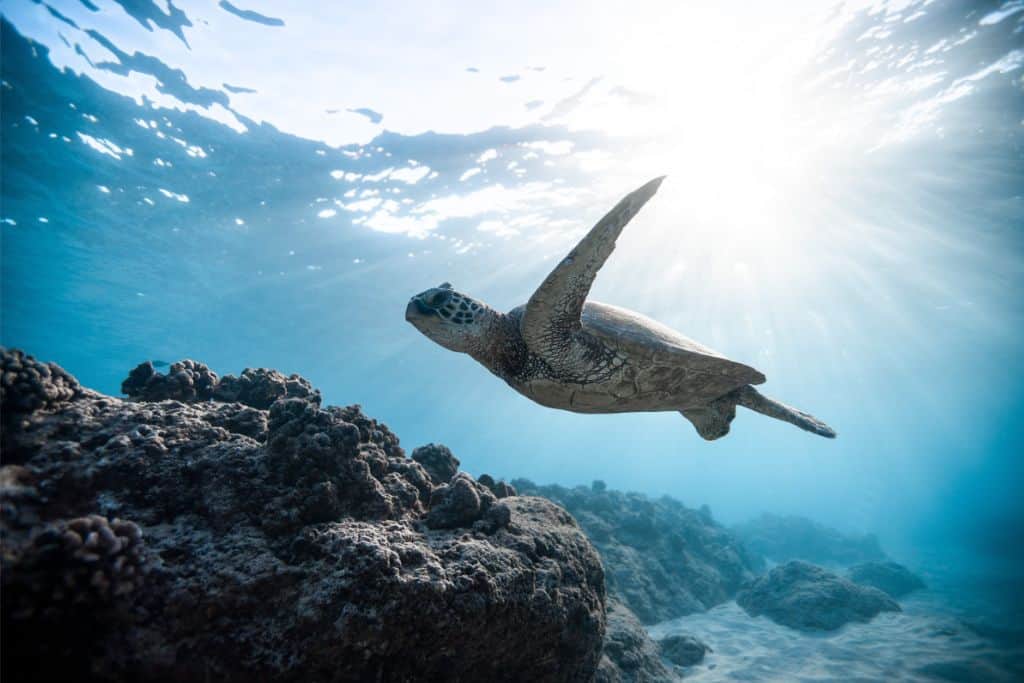
4. Curaçao
Sister island to Aruba and Bonaire, Curaçao is the largest of the ABC islands. There are over 30 beaches, but the calmest for snorkeling with young kids is in the west coast’s sheltered bays.
5. Bonaire
Bonaire is a pioneer in coral conservation as the world’s first Blue destination; as a result, snorkelers enjoy some of the most flourishing reefs in the world. It’s also possible to get to some great spots from the beach such as 1000 Steps.
6. Rangiroa, Tahiti
At the Blue Lagoon you can snorkel right from your dining table into the warm waters of the baby shark nursery and swim with dozens of black-tip reef shark with your own baby shark! And at Tiputa Pass you can drift with the famously friendly, wild bottlenose dolphins.
7. Mauritius
At Blue Bay Marine Park visibility is near-perfect and it’s great for beginners and young kids, as you can snorkel straight from the beach. The park is home to angelfish, damselfish, parrotfish, and clownfish—among other colourful exotics.
8. Antigua
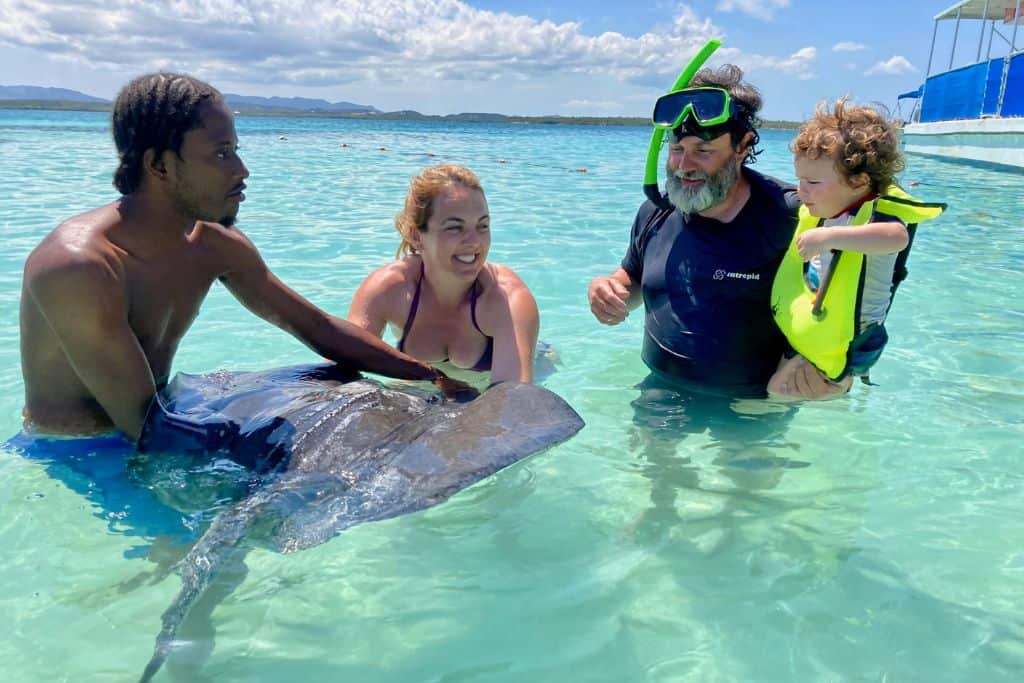
We had to put Antigua on the list as it’s where we’ve done all of our snorkelling with Cam. It has some great shallow coral reefs for spotting sea turtles and we’ve seen lots of different rays. It’s also home to Stingray City where a tour guide will help you to snorkel, feed and swim with sting rays. We love it as you don’t need to be strong swimmers to enjoy it.
9. Anguilla
With water visibility of up to 100 feet, Anguilla is a paradise for snorkelers of all abilities. There are so many awesome spots to chose from for a dip such as exploring the monumental coral gardens (some more than eight feet tall) off Great Dog Island, which is inhabited only by feral goats.
10. Kauai, Hawaii
Snorkelling here is all about the chance to swim with elegant Green Sea Turtles in the waters off this stunning Hawaiian island. The best months for snorkelling are October through April.
11. Whitsunday Islands, Australia
Bait Reef has some of the most amazing coral formations in the world, and the most famous are The Stepping Stones. These are made up of nearly 20 flat-topped pinnacles lined up like soldiers in formation. Each rises from a depth of 80 feet and stop only three feet from the surface which is perfect for young snorkelers. They are completely covered with coral so you should be on the lookout for the small tropical fish that swarm around the tops of the stones.
12. Moorea, French Polynesia
Moorea is a secret favourite of snorkel fans looking for an up-close-and-personal encounter with black-tip reef sharks. The best place to find the sharks is in the lagoon facing Motu Irio.
13. Seychelles
Made up of of 115 tiny islands, the Seychelles is one of the best spots in the Indian Ocean for snorkelling.
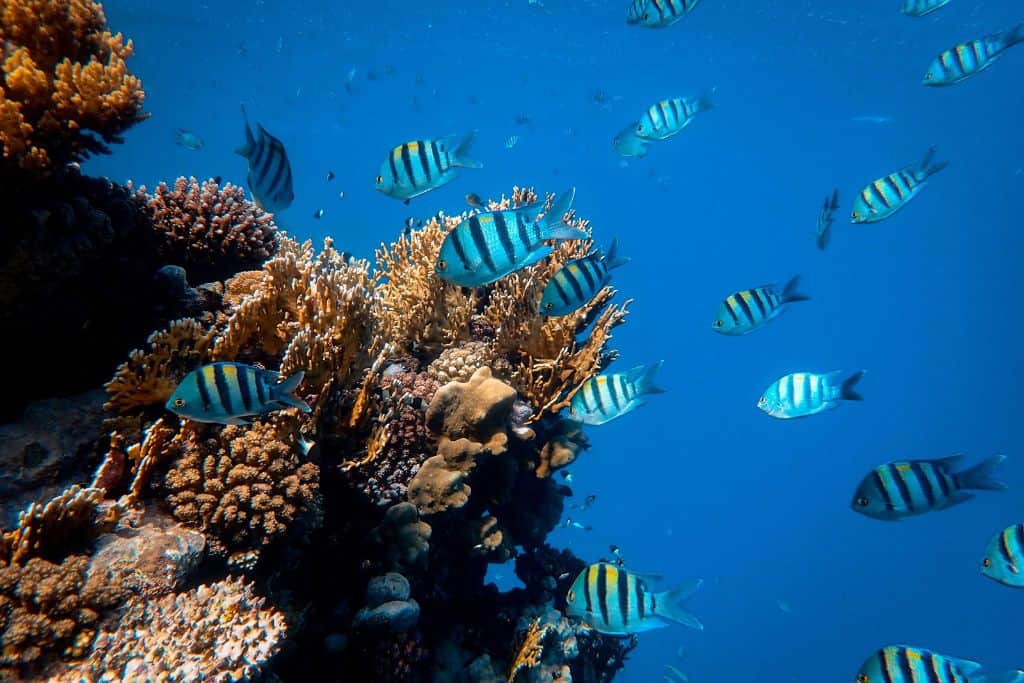
14. Phi Phi Islands, Thailand
The Phi Phi Islands are home to arguably the best snorkelling spots in the world. You’ll snorkel in incredibly clear, turquoise water surrounded on both sides by 330-foot-tall limestone cliffs.
15. Bora Bora, French Polynesia
Snorkelling in Bora Bora couldn’t be any easier because so many companies offer accommodation in overwater bungalows. Don’t miss snorkelling in the waters off the southern tip of the main island. There you’ll find reef sharks, friendly stingrays, and colourful fish (and the manta ray cleaning station on the east side at Anau).
16. Vieques, Puerto Rico
Cast just off the eastern coast of Puerto Rico, Vieques is still an off the beaten path Caribbean destination. Most of the island was once a U.S. Navy training area and still remains completely undeveloped. Green Beach has shallow, clear water, a great variety of marine life, and you’ll have it pretty much to yourself as it is rarely crowded.
17. Maui, Hawaii
Maui has lots of amazing snorkel spots. However, for something completely different you can sail out to Molokini Crater—a tiny, volcanic crescent off the island’s southernmost shore. A State Marine Life & Bird Conservation District, this is home to dolphins, manta rays, turtles, and dozens of varieties of insanely colourful tropical fish.
18. Sipadan, Malaysia
Sipadan is located off of the island of Borneo is best known for world-class diving, and described as an “Untouched Piece of Art” by Jacques Cousteau himself. What’s great is that even the snorkelling there is equally stunning with easy viewing of other worldy coral formations, sea turtles, and Bumphead Parrotfish.
19. Palawan, Philippines
Palawan has been voted one of the top islands in Asia. Day trips by boat from Puerto Princesa to Luli Island, Starfish Island, Panden Island, and Cowrie Island only take 45-minutes. Once there you will be rewarded with sightings of starfish and sea snails, plus a marine gastropod mollusca called “cowrie.”
20. The Maldives
Found in the Indian Ocean, this chain of 26 atolls and over 1,000 islands is one of the world’s most geographically dispersed countries and can’t be beaten for underwater exploration.

Snorkelling with kids FAQs
The best age to start snorkelling will vary between small children. Generally speaking, kids aged four to five have the physical and developmental capabilities suited to enjoying beginner snorkelling experiences. The main this is to always consider the individual child’s comfort level and swimming ability when deciding on the right time to introduce them to snorkelling.
Yes they absolutely can. A water confident three-year-old can totally join in on the snorkelling action with the right preparation! You’ll need to find appropriate-sized gear, calm and shallow waters. With the right encouragement and adult supervision, even very young kids can have a wonderful introduction to the underwater world, fostering their curiosity and sense of adventure.
Snorkelling is possible even if you cannot swim so long as appropriate precautions are taken into consideration. Young kids should always be kept under close supervision. For extra safety a floatation device such as a life jacket or snorkel vest must be worn if they are not competent and confident swimmers. For additional reassurance, take a snorkelling tour guide and stay close to the boat or shore.
Safety is always the top priority when selecting any snorkelling gear for you and your young kids. There are many options including full-face snorkel masks, however, it is worth investing in well-fitting and good-quality snorkels, fins and masks.
We’d avoid buying cheap sets as they can leak and break easily and are unsuitable for open water. Whilst fins will make a difference to their speed and ability to free-dive, they are not necessary for young kids in calm water.
Final thoughts on snorkelling with kids
As an entire family we love snorkelling, there’s something really special about snorkelling with kids. It’s the way that they are so excited about suddenly being able to see a whole new landscape. We really hope that you find our steps helpful and that you and your whole family have a great time snokelling together.
